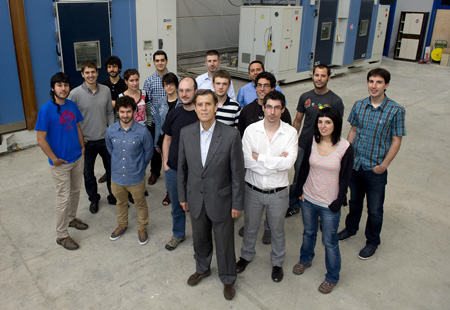Sep 6 2013
The ENEDI (Energy in Building) Group of the UPV/EHU-University of the Basque Country is working to improve the quality of homes and all existing buildings in general in line with the criteria established by European directives on energy saving, thermal insulation and energy efficiency of buildings, as well as other criteria of sustainability, habitability, durability, functionality and maintenance.
 The ENEDI Group of the UPV/EHU, in the Thermal Area of the Quality Assurance in Building Laboratory (LCCE) of the Government of the Basque Autonomous Community.
The ENEDI Group of the UPV/EHU, in the Thermal Area of the Quality Assurance in Building Laboratory (LCCE) of the Government of the Basque Autonomous Community.
Right now, an experimental installation is being set up. It is being used to test the energy technologies that are expected to be gradually incorporated into buildings over the next few years.
So ENEDI's lines of research are being developed in the area of energy efficiency in buildings, not only with respect to their envelopes (particularly the processes in which heat and humidity are transferred) but also the energy behaviour of their installations. "Our research is largely geared towards the lines that may be of greatest interest to the Housing Department of the Government of the Basque Autonomous Community (region)," explained Jose Mª Sala-Lizarraga, head of the Department of Thermal Engines and Motors of the UPV/EHU-University of the Basque Country.
Saving energy
For example, the previous Government published its "Plan Revive", through which it provided grants for between 600 and 700 apartment owners to undertake the full rehabilitation or regeneration of their apartment blocks. "To obtain these grants the owners have to show that they have been able to achieve a certain amount of energy saving thanks to the rehabilitation. We advise the Department of Housing on what kind of sensors and what kind of data gathering system would need to be fitted to each block," added Sala. Later on the moment will come to gather the data (temperature, humidity, consumption readings) and the right way of processing the data, so that we can assess the actual energy savings made possible by the rehabilitation.
Recently, an Agreement was signed between the UPV/EHU and Municipal Housing (VVMM) of Bilbao to develop the programme "Energy Savings in Home Rehabilitation". VVMM runs and maintains properties numbering about 4,000 social housing category homes and "we collaborate by advising them on rehabilitation work. Once the block has been rehabilitated, we do the relevant monitoring and data analysis of the building to quantify the energy savings," he explained. The aim is to improve the comfort of the tenants living in the social housing by improving the envelope of the building by means of proper insulation that reduces heat loss and improves the installations; the aim is to ensure affordable energy consumption for people of limited resources and enable them to enjoy a certain amount of comfort inside their homes.
Energy installations in buildings
To study the energy behaviour of the installations, a new line of work in connection with energy installations in buildings has recently been added. For this purpose they have fitted an experimental installation that is used to test the energy technologies that are going to be incorporated into the buildings over the next few years in order to obtain information that can be used by the different agents in the building sector. This installation foresees the introduction of conventional equipment or microgeneration with renewable energy installations, including mini wind generators, thermal solar power, photovoltaics, etc. At the end of the day, this testing installation is going to allow us to gather data on the functioning of different types of equipment to which different operation strategies are going to be applied. This information will make it possible to evaluate the most efficient technologies, the best integration between two different types of equipment, as well as the operation modes that will mean lower energy consumption.
It will be a test bank for the new equipment that is going to be installed in the public promotions of the Department, of Visesa, and after that of other private bodies and promotions that are in favour of such a move.
Likewise, "we have applied for a patent for our own design of an energy storage system based on phase change materials (from solid to liquid and from liquid to solid). We felt it would be interesting to protect it and last year we applied for a patent. We are waiting to receive the answer," added Sala.